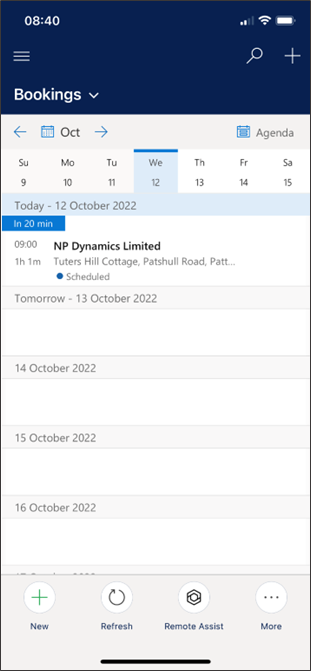The Dynamics 365 Field Service app gives us a cool feature to manage inspections. In this post I will give an overview of this feature.
What are Field Service Inspections?
The Field Service app of Dynamics 365 is aimed at engineers completing work onsite. A common requirement for field engineers is to complete inspections. Maybe this will be part of a preventative maintenance contract when the engineer will test (aka inspect) the installed devices on a recurring basis.
Meaning inspections are essentially forms which can be shown as part of a work order. Inspections can optionally being associated with a particular piece of equipment (customer asset), meaning we can build an inspection history for each installed device.
The inspection questions may evolve overtime, meaning inspection versions allow administrators to update and publish new versions as and when required.
As inspections can be completed from the Field Service mobile app they support offline access.
Inspection Creation
The process of creating an inspection involves an administrator creating an inspection template. These templates can then be linked to one or more service tasks.
Service tasks can then be added to work orders.
When an engineer accesses a work order they see the associated service tasks and can therefore complete the inspections.
Dispatchers and other staff (back at the office) can then view, export and report on the completed inspections.
Creation inspection Templates
We create in the settings area of the Field Service app. (As shown below.)

Having created your template, the first thing you will probably do is to add a name and description to your template. You can then save the template and begin adding questions.

Question types
If you have used Microsoft’s survey tool “Customer Voice” you are going to find the approach to maintaining the inspection templates very familiar. But even if you haven’t, don’t worry, as the interface is intuitive. You simply drag potential questions of various types from the toolbox panel and drop them into your template.

Once the question has been added you can amend the question using the “pencil” items. For example, on a checkbox question you might want to change the question text and available options. Or maybe you use the “Required” option to force the engineer to give an answer to this question.

Tips:
- Other – use this to prompt the engineer for a reason if this option is selected.
- Select All – use this to give the engineer a quick way to tick all options.
- None – use this option to give the engineer a quick way to untick all options.
I won’t cover all the options for every question type here! I suggest you experiment with each one to understand how it might be useful to you. But the types include;
Textbox : great if you want to capture a comment.
Checkbox : Great when multiple options from a list could be selected.
Radiogroup : Use this when only one option from a list can be selected.
Dropdown : in some respects gives a similar result to a radiogroup! But instead of buttons engineer picks from a drop down list of options.
Entity lookup : Can present a list of options in a lookup from a dataverse table.
Number : Allows entry of a number (options allow us to apply an input range etc.)
File : Allows engineers to upload files and attach to the inspection. (Might be useful if you want to capture a photo!)
Matrix (Dynamic) : presents a grid the engineer can complete and allows then to add additional rows during the inspection
Logic
The logic tab helps us to build conditional questions into our inspections. Say of the engineer records that an asset is faulty, maybe then you want additional questions to show. (Such as asking them to take a picture of the failed item!)

We can use the logic tab to create rules which conditionally show questions, make questions mandatory (required) or skip to certain questions.
Compact view
As we preview questions they will initially be rendered in the “comfortable” (aka default) manner.
But if you navigate to the advanced panel with no question selected it is possible to amend the view to a compact format. You might want to experiment wit this to see which format works best for your engineers.
We can also opt to hide the inspection titles and question numbers.
Tip: If you click on the advanced tab and you don’t have the option to change to the compact view. Try clicking on your inspection title or description and then navigate to the advanced tab again!

Pages
Often each inspection will only have one page. But you can optionally add pages into your inspections.
You might want to do this to organize groups of questions into logical groups. Or maybe your logic rules would “skip” to the question at the top of the next page.
Below you can see how I could add a new page in the designer. Also notice that I can optionally add a page title and description as required.

Translations
We even have an advanced option to create language translations of each inspection.
Before you can use this option, you’ll need to install one (or more) language packs. You can do this in the advanced settings area of Dynamics 365. Or from the settings area of the Power Platform admin center. As the language is going to need to be available to the engineers mobile app!

You can then use the translation tab to select one or more languages and enter the translations for each.

Publish
Once you are happy with the inspection you use the “publish” option to make it live.
We have two publish options!
“Publish” will just publish the inspection template.
But “Publish and Generate a new Service Task Type” will, as the name suggests, generate, and open a new task type. This is useful when you first create an inspection as typically you are going to want to associate the inspection with at least one service task type. (As that is essentially to be able to add the inspection into a work order.)

If you need to alter a published template, then you use the “Revise” option. This will create a new draft version based on the published version of the template.

Associate with service task types
How we have an inspection template it can be associated with one or more service task types. As already mentioned, you can create a service task type as you publish the template. Alternatively, you can simply create a new service task type and pick your inspection.
Below you can see that I have opened a service task type.
Notice that I have accessed my service task types from the right-hand navigation, in the settings area of my Field Service app.
I have then selected the “Has Inspection” option. And once done I can pick my published inspection template. Usefully below this I can see a preview of how the inspection associated with this task type will show.

Now my service task type has been created I am ready to add it to work orders, incident types or agreement booking setups.
Add inspections to work orders
We add inspections to work orders by adding service tasks. There are three ways to add service tasks that you might want to consider.
Manually, as a work order is created the dispatcher can simply add one (or more) service tasks.
Alternatively, you might want to add service tasks to your incident types. Then whenever a work order is created based on this incident type the service tasks will automatically be added.
The final approach uses agreements. Agreements are ideal if you have a “planned preventative maintenance” (PPM) contract. As the agreement allows the definition of logic for the regular maintenance work and will automatically generate work orders. Obviously, this involves quite a bit of setup! But if you frequently offer “service contracts” to your customers they maybe an excellent way to manage those contracts.
Below you can see that I have created a work order. Then on the “Service Tasks” tab I can add one or more service task types that will be associated with this work order. When doing this the task types can be associated with inspections but is equally valid to have a service task that doesn’t need an inspection.

As mentioned, I can also add service task types to incident types or agreement booking setups. If I do this then whenever an incident type is associated with a work order or a work order is generated for an agreement then service tasks will automatically be added to my work order.
The incident types are of particular use! As you can use these to aid the quick creation of work orders that commonly have a repeating set of service tasks.
Perform inspections
The engineer will typically complete inspections using a mobile device! So I have show screens from my mobile phone below!
Below you can see that as an engineer I have a booking in my calendar. (Found in the Field Service mobile app.)

Opening my booking and navigating to the service tab will show the engineer what tasks they need to complete. Notice that my first task as an “inspection” icon, so I know that task has an associated inspection.

With service task types that don’t have an inspection the engineer will commonly simply click on the circle, which automatically marks the task as complete.

With an inspection task clicking the circle (for the first time) will open the service task and its associated inspection. The engineer can the simply complete the inspection details as instructed. (Even accessing the phones camera is a photo of the equipment being inspected is required.)

Now when they engineer saves the inspection, they can click on the circle icon again to show their inspection work has been completed. (Or they could click the inspection icon again to re-load the inspection and edit their findings!)

Once all the tasks have been completed the engineer would complete the work order in the normal way. And the dispatcher in the office will then be abel to see that the work order is complete and view the associated inspection details.
View inspections
Below you can see that if the dispatcher opens the work order, they can use the service tab to see the status of the service tasks.

Below you can see that my dispatcher has opened the service task “Equipment Inspection” and can view the results entered by the engineer.

Other “concerns”
Security roles
A note about security roles might be important! Three out of the box security roles exist which influence inspection usage. You will need to decide which roles your staff will need.
Field Service – Administrators: people with this role can create inspection templates and service task types.
Field Service – Dispatchers: dispatchers can add service tasks (with inspections) to work orders.
Field Service – Resource: Can view their work ordered and complete the associated service tasks and inspections.
Export of inspections (future posts)
We can export inspection results as pdf files. And export our templates for import into other environments. I plan to cover these options in a future post!
Reporting (future posts)
You may want to produce various reports on the number of inspections completed etc. Possibly you’d like to format the data in a way that you can easily create Power BI reports. I also plan to cover the approach to reporting in a future post!
I hope this post has given you a good overview of Field Service inspections. And as mentioned I will expand on this information in future posts. Enjoy.






Leave a comment